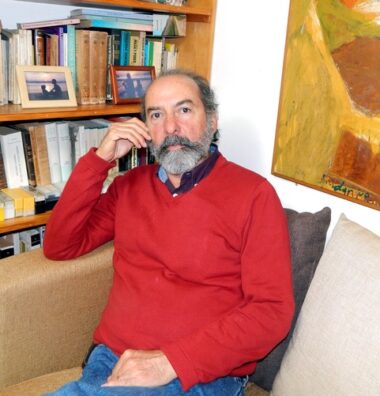
- This event has passed.
Julio Amador Bech- “Rain and Fertility Symbolism in the Rock Art and Cultural Landscape of the Trincheras Sites of Northwestern Sonora
March 20, 2023 @ 7:00 pm - 8:30 pm MST
This event is open to the public. To register CLICK HERE
Trincheras archaeological sites of northwestern Sonora (A.D. 200 – 1450) are located in the lower Sonoran Desert, along the Magdalena, Altar, and Asunción/Concepción river drainages and adjacent volcanic hills. The Trincheras tradition is characterized by terraced hill-sides with stairs, ramps, and pathways connecting the terraces (trincheras). On the summits are stone alignments serving as observatories with views to the heavens and surrounding landscape. In the foothills are bedrock mortars and metates. On the adjacent plains are plazas, rock alignments, shallow pithouses, roasting pits for cooking agave, and domestic debris, such as shell artifacts, lithic debitage, and potsherds representative of the Trincheras complex. The terraced hills and adjacent plains contain thousands of petroglyphs. These rock engravings are concentrated in areas with heavily patinated rocks and where creeks form during the rainy season. Examined collectively and in conjunction with ethnohistoric, ethnographic, and astronomical data, we suggest Trincheras archaeology reveals a complex cultural system that provided the community with collective goals transcending the immediate needs of food, shelter, and defense. The archaeological remains within their landscape settings are microcosmic expressions of a larger cosmological scheme involving increased rituals related to rain production and fertility. They demonstrate the cultural uniqueness that human action on the landscape adopted in these sites and reflect the complex cultural relations that this tradition had with its neighbors from northwestern and western Mexico as well as with the American Southwest, such as the Hohokam and Pueblo. Further, Trincheras archaeology manifests important cultural traits associated traditionally with the complex cosmologies and mythologies of Mesoamerica, but that are earlier expressed in Archaic period rock art that can be found northward, in the American Southwest.
 Julio Amador Bech is a Professor in the Political and Social Sciences Faculty at the National Autonomous University of Mexico [Universidad Nacional Autónoma de México] (UNAM). He specializes in Cultural Anthropology, Archaeology, Communication, Hermeneutics, and the Anthropology of Art. He has been a Level II National Researcher in the National System of Researchers (SNI) since 1980 dedicated to research in the above areas. From 2016 until present Julio developed and is carrying out a research project on rock art in Chalcatzino Morelos, Mexico and is developing research on the rock art of the Sonoran Desert in Mexico. Julio has published eight books about anthropology, archaeology and hermeneutics with UNAM, many chapters in collective books and 37 articles in specialized scientific journals.
Julio Amador Bech is a Professor in the Political and Social Sciences Faculty at the National Autonomous University of Mexico [Universidad Nacional Autónoma de México] (UNAM). He specializes in Cultural Anthropology, Archaeology, Communication, Hermeneutics, and the Anthropology of Art. He has been a Level II National Researcher in the National System of Researchers (SNI) since 1980 dedicated to research in the above areas. From 2016 until present Julio developed and is carrying out a research project on rock art in Chalcatzino Morelos, Mexico and is developing research on the rock art of the Sonoran Desert in Mexico. Julio has published eight books about anthropology, archaeology and hermeneutics with UNAM, many chapters in collective books and 37 articles in specialized scientific journals.
Suggested Readings:
Amador Bech, Julio
2008 El significado de la obra de arte, Conceptos básicos para la interpretación de las artes visuales, UNAM, Mexico City.
2011, Cosmovisión y cultura. Tradiciones míticas de los o’odham: su relación con el entorno natural y la vida social, FCPyS-IIA-UNAM, Mexico
2017 Símbolos de la lluvia y la abundancia en el arte rupestre del desierto de Sonora, Secretaría de Cultura/ENAH-INAH/Mil Libros Editores, Mexico City, Amador Bech, Julio and Adriana Medina.
Elson, Mark D.
2008 Into the Earth and Up to the Sky: Hohokam Ritual Architecture. In The Hohokam Millenium, edited by Suzanne K. Fish and Paul R. Fish, School for Advanced Research Press, Santa Fe, NM.
Cole, Sally J.
2009 Legacy on Stone. Rock Art of the Colorado Plateau and Four Corners Region, Johnson Books, Boulder.
Fish, Susan K. and Paul R. Fish
2007a Regional Heartlands and Transregional Trends. In Trincheras Sites in Time, Space and Society, edited by Fish, Fish and Villalpando, The University of Arizona Press, Tucson.
2007b Una mirada desde las alturas. Elementos arquitectónicos e ideología en los cerros de trincheras. In Memoria del Seminario de Arqueología del Norte de México, edited by Cristina García M. and Elisa Villalpando, Coordinación Nacional de Arqueología-Centro INAH Sonora, PDF-CD Version.
Lindauer, Owen and Bert Zaslow,
1994 Homologous Style Structures in Hohokam and Trincheras Art. In The Kiva, Vol. 59, Number 3, pp. 319-344.
Navarrete Linares, Federico
2011 Los orígenes de los pueblos indígenas del valle de México. Los altépetl y sus historias, Universidad Nacional Autónoma de México, Mexico City.
Zavala, Bridget.
2006 Elevated Spaces: Exploring the Symbolic at Cerros de Trincheras. In Religion in the Prehispanic Southwest, edited by VanPool Christine S., Todd L. VanPool and David A. Phillips Jr., AltaMira Press, New York
 All Events
All Events